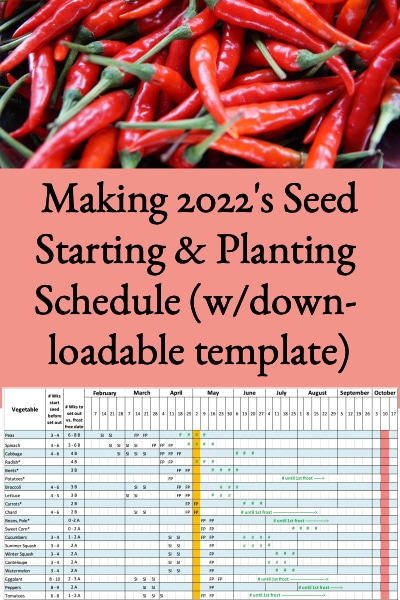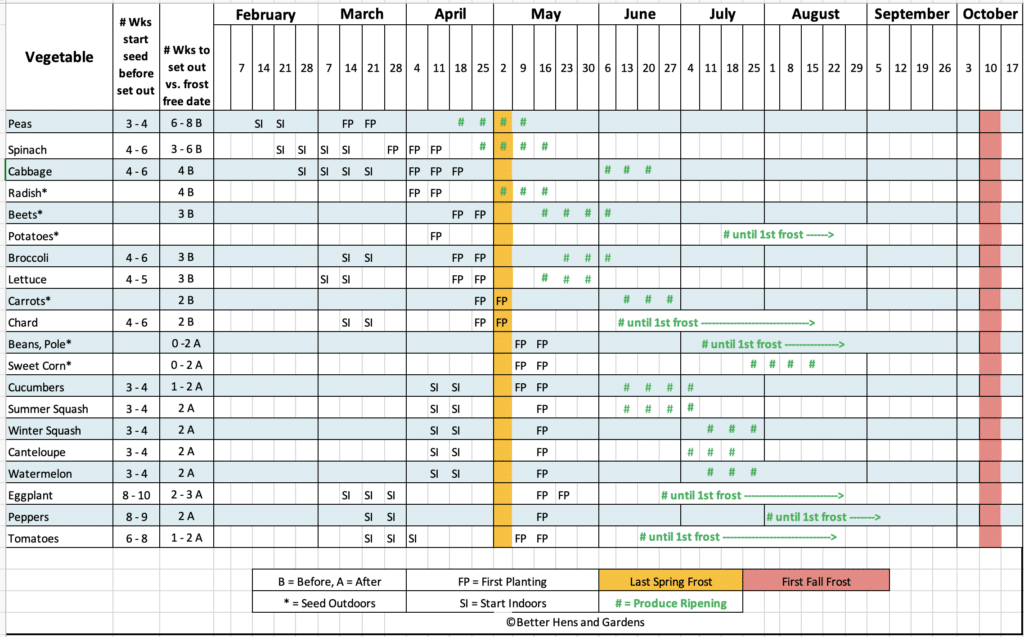
It helps me keep focused on buying seeds, starting transplants, getting supplies, and making sure the garden beds are prepared on time.
I start with my schedule from the previous year, copy it to a new spreadsheet tab, consult my notes from last year’s garden, and then work up the new plan.
I’ve included a downloadable template (2022 Seed Starting & Planting Template) if anyone wants to start with my basic Excel spreadsheet and modify it for your planting zone (you can find your hardiness zone at the USDA site HERE).
I’ve included the number of weeks to start seeds before setting outside (column 2) and the number of weeks before or after the last spring frost date for transplanting to the garden (column 3) to make it easier for creating schedules.
The actual dates and schedules for things can vary significantly depending on the conditions each year; however, by doing this and keeping notes, you can begin to develop a pretty good feel for how your garden’s schedule will go.
2022 Spring Seed Starting & Planting Schedule
2022-Vegetable-Planting-Schedule

Making Your Own 2022’s Seed Starting & Planting Schedule
Identify Your Last Spring Frost Date & First Planting Dates
To make a schedule for your garden, just take the Excel spreadsheet and adjust the “Last Spring Frost” column to reflect the week of the last spring frost (orange column or week of May 2 in my schedule) for your location. Next, identify the appropriate first planting (FP) date for each vegetable. To find the last spring and first fall frost for your location, you can simply enter your zip code on the form HERE.
For example, since peas are very cold tolerant, column 3 identifies they can be put out 6 – 8 weeks before the last spring frost. So, in my schedule, peas can be put out the week of March 14 – March 21, six to eight weeks ahead of my week of May 2 last spring frost date.
Establish When To Start Seedlings or Sow Outdoors
Once you’ve got your first planting dates, you can establish the dates for starting seedlings indoors (SI) for those vegetables that you intend to transplant. So, using peas again, column 2 says they should be started indoors 3 – 4 weeks before setting out.
Based on that, I backed up three and four weeks and identified that peas should be started indoors the weeks of February 14 or 21 if I want to transplant them into the garden rather than direct sowing (to get the earliest possible peas). For those vegetables that are directly sown outdoors, only the first planting dates need to be established – like the radishes in my schedule.
Identify When Plants Will Begin Producing
Now, I like to know approximately when production will start (#) for each vegetable. To do this, find the days-to-maturity number for each variety (should be on the seed packet), divide by seven for weeks, and move forward that many weeks on the schedule to identify when your plants will start producing.
So, using my pea example again, my earliest is identified as 52 days-to-maturity which means about 8 weeks. Counting 8 weeks forward from my February 21 seeding date puts me on April 18 for the first production.
Indicate How Long Productions Should Last
Once you’ve identified when production will start for each vegetable, then indicate how long it will continue based on the first planting. Using peas again, once the peas start producing, they should continue for a couple of weeks, so I show that by indicating pea production in the weeks of April 18 through May 9.
For vegetables that will continue to produce until frost, indicate with “# until frost —>” as shown for chard, beans, etc. For those vegetables that only produce for a limited time, remember that you can often use succession planting to extend the harvest.
Do the above for each vegetable you’re growing and you’ve got a handy schedule for planting your garden, and if you keep notes and tweak it each year, it will only get better.
Tips For Using Your Seed Starting & Planting Schedule
I’m being quite aggressive on our seed starting and planting schedule; based on previous year’s experience and the fact that the USDA has now revised our Zone to 6A.
It pays to get things out to the garden as soon as possible and to really improve production, I’m also starting to use faster-maturing varieties – they can drastically improve when production actually starts.
If you need some free garden seed catalogs to select varieties from, there are links to order them on the Free Garden Seed Catalog Links post.
That’s the great thing about taking the time to create a schedule like this; it can be adjusted from year-to-year, so you can get better at timing things. I need to get busy organizing supplies soon, it’s almost time to start transplants!
Jen says
Thank you for this! Great template to start out with. I’m here in New Zealand so our growing season is the other way around but this template made it so easy to customise it for where I am.
Lesa says
Hi Jen, I’m so glad it’s helpful even in New Zealand!
Tiffany says
Thank you for creating this. I find it very user friendly. I added a few things for succession plantings and created a second tab for herbs/edible flowers. I’ll likely create a third tab for the rest of my annual flowers and perennials. 🙂
Loui says
Thank you!
Lesa says
You’re welcome Loui!
Carly says
This is amazing! I was just sitting down to create a spreadsheet and thought someone else must have had the same idea. I did a quick Google search and I found your beautiful, helpful spreadsheet. Bonus – we’re in the same zone! You’ve saved me so much time! Since I plant flowers as well as vegetables, I copied the whole sheet into a second tab that I’ll edit to log the annual and perennial flower seeds I’m sowing this year. Thanks so much for sharing your lovely resource. I apprecite your generosity!
Tobhiyah says
Ohhh my Garden. I love you. I have been struggling along with a spreadsheet that’s just confusing. Thank you so so much for sharing this with us! I went ahead and shared it in my Gardening group on FB. wishing you all the success in the world. Happy Planting and thanks for making the world a more beautiful and healthy place. PS. Do you happen to have anything like this for starting flowers, striating etc?